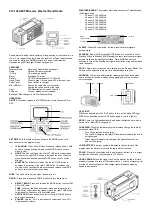
Chip Component
Replacing Chip Components
Chip components are installed at the factory by a series
of robots. The first one places a spot of adhesive resin at the
location where each part is to be installed, and later robots
handle and place parts using vacuum suction.
For single-sided boards, solder paste is applied to the
board is then baked to harden the resin and flow the solder.
For double-sided boards, no solder paste is applied, but the
board is baked (or exposed to UV light) to cure the resin be
fore dip-soldering.
In
our laboratories and service shops, small quantities
of chip components are mounted manually by applying a spot
of resin, placing with tweezers, and then soldering by very
small dual streams of hot air (without physical contact dur
ing soldering). We remove the parts by first removing solder
using a vacuum suction iron, which applies a light, steady
vacuum at the iron tip, and then breaking the adhesive with
tweezers.
The special vacuum soldering/ de-soldering equipment is
recommended if you expect to do a lot of chip replacements.
Otherwise, it is usually possible to remove and replace chip
components with only a tapered, temperature controlled sol
dering iron, a set of tweezers and braided copper solder
wick. Soldering iron temperature should be below
280 °C
(536F).
1 -4
Precautions for Chip Replacement
Do not disconnect a chip forcefully, or the foil pattern
may peel off the board.
Never re-use a chip component. Dispose of all removed
chip components immediately to avoid mixing with new
parts.
Limit soldering time to 3 seconds or less to avoid dam
aging the component and board.
Removing Chip Components
@Remove the solder at each joint, one joint at a time, using
solder wick wetted with non-acidic flux as shown below.
Avoid applying pressure, and do not attempt to remove the
tinning from the chip's electrode.
@Grasp the chip on both sides with tweezers, and gently
twist the tweezers back and forth (to break the adhesive
bond) while alternately heating each electrode. Be careful
to avoid peeling the foil traces from the board. Dispose of
the chip when removed.
@ After removing the chip, use the copper braid and
soldering iron to wick away any excess solder and smooth
the land for installation of the replacement part.
FT-51R Technical Su1J1Jlement
Summary of Contents for FT-51R
Page 8: ...1 6 FT 51R Technical Suoolement...
Page 12: ...2 4 FT 51R Technical Suoolement...
Page 14: ......
Page 26: ......
Page 28: ......
Page 30: ......
Page 32: ......
Page 34: ......
Page 44: ......
Page 46: ......
Page 54: ......
Page 56: ......
Page 58: ......
Page 68: ......
Page 72: ......
Page 76: ......
Page 78: ......
Page 80: ......
Page 82: ......







































